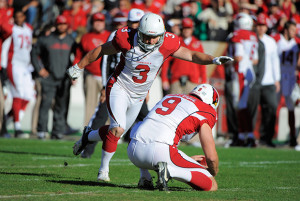Kicking a field goal down by 18 this late in the game is a poor decision unless it’s fourth and impossible. Since 1940, do you know how many teams have kicked a field goal, when trailing by 18 or more points in the second half, and went on to win the game? THREE. The “They Are Who We Thought They Were” game, when Chicago kicked a 23-yard field goal down 20-0 midway through the third quarter. After that field goal, Mike Brown, Charles Tillman, and Devin Hester scored touchdowns for the Bears, which doesn’t seem like the best model to follow in the future since none of those players played offense.
In 1998, the Rams kicked a field goal in Buffalo to make it 28-13 in the third quarter, ultimately winning 34-33 on a touchdown run in the final seconds. And in 1996, in Bill Parcells’ return to the Meadowlands to face the Giants, Adam Vinatieri kicked a third-quarter field goal down 22-0, and then Terry Glenn, Dave Meggett (on a punt return), and Ben Coates scored fourth quarter touchdowns.
You know what hasn’t happened? A team kicking a field goal, down by 18 or more points in the fourth quarter, and going on to win the game. Including the two teams this year, 117 teams since 1940 have kicked a fourth quarter field goal when trailing by more than 17 points, and none of them have ever won. I know, trailing by 18, it’s so comforting to kick a field goal and think “hey look, all we need to do is stop them, score a touchdown, stop them again, score a touchdown, convert a two-point conversion, and then win in overtime.” But that’s never, ever happened before.
According to Brian Burke, the Cardinals had a 3% chance of winning the game if they kicked the field goal, a 1% chance of winning if they failed on 4th down, and a 10% chance if they converted and scored a touchdown. Those numbers seem reasonable to me, but maybe you want to use different numbers. It doesn’t really matter. When you’re that big of an underdog, you need to play aggressively. You’re almost certainly going to lose, and you’re only chance of not losing is having some high-leverage plays go your way. For the avoidance of doubt, a 22-yard field goal is not considered a high-leveraged play.
Using Burke’s numbers, Arizona would have needed only a 22% chance of converting on 4th-and-goal from the 4 to make it the right move mathematically, as he estimates that the league-average conversion rate is 42%. You might think “well sure, but against the Seahawks defense, Arizona’s chances were much lower of converting.” To the extent that such a proposition is correct, what does that mean for the chances of the Cardinals to put together two touchdown drives over the rest of the game?
In a vacuum, Arians didn’t give up much, reducing his team’s win probability from five percent (by choosing to go for it, without knowing the outcome) to three percent (of course, while a different of two percent in win probability is small, a reduction of 40% is quite large). But the more important takeaway is that Arians, coaching a huge underdog, chose the most conservative option possible. He picked a route that has literally never led to victory in NFL history.
(On an unrelated note, I will give Arians credit for going for two later in the game with the team (before the score) trailing by 18, an analogous situation to one I outlined last year.)

